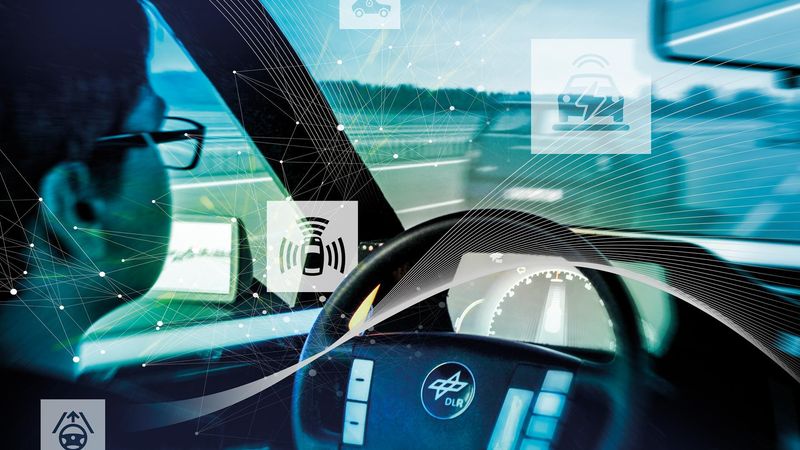How can autonomous driving gain trust and approval?
Highly automated and autonomous driving are getting ever nearer to becoming a reality. This technology holds the potential to make transport systems safer, more efficient and more convenient.

The future of mobility – automated and networked driving. Credit: © DLR. All rights reserved
Highly automated and autonomous driving are getting ever nearer to becoming a reality. This technology holds the potential to make transport systems safer, more efficient and more convenient. IT systems will play a key role in this, as they control the vehicles, connect them as part of a network and link them with various infrastructure components. These highly complex systems are the focus of the research work being conducted at the German Aerospace Center (Deutsches Zentrum für Luft- und Raumfahrt; DLR) Institute of Systems Engineering for Future Mobility. This new DLR institute is based at Oldenburg, in Lower Saxony. It is a spin-off from the Transport Research Division of the OFFIS Institute for Information Technology, a computer science research organisation, and is building upon 25 years of experience in research. More than 100 former OFFIS personnel have now found a new home in DLR Transport Research. We interviewed Institute Director Axel Hahn to find out about the topics, key areas of focus and goals of the Institute.
What does 'systems engineering' mean, exactly? Which subjects and key areas of focus are you dealing with?
Axel Hahn: We are investigating the dependability of highly automated and autonomous systems. These kinds of systems will soon be used in road transport, and on trains and ships. The abstract term 'system' refers to many components that use machine learning and artificial intelligence methods, along with large amounts of data. We are developing methods to test and further develop these complex systems. Our research is fundamental for ensuring the safety, certification and insurability of highly automated and autonomous means of transport. It is also important for gaining people's trust and bringing about the widespread acceptance of such technologies.
What form does all this take in practice? Who are you working with?
Hahn: Essentially, we help companies, test facilities and certification authorities to make systems for highly automated and autonomous driving safer and eligible for approval. This is now an important topic within the industry, and we are addressing the very heart of the problem. No complex system can predict all of the possible areas of application, so they need to be continuously improved. During operation, these systems are constantly collecting and evaluating new data. This means that both the developers and the systems themselves are learning during this process of constant improvement. Our methods and tools are aimed at supporting this continuous process. This enables us to check whether the software and overall systems are working properly and are suitable for practical applications. This opens the way for comprehensive quality assurance.
Even before our integration into DLR, we worked closely with many DLR institutes, primarily in the field of transport research. We are now intensifying this collaboration through joint projects and initiatives. DLR's Test Field Lower Saxony constitutes an enormously beneficial infrastructure for highly automated and networked road driving; it is unique in Europe. Simulation and practice are already aligned there. By establishing this new Institute, DLR now also has a maritime test field – the eMaritime Integrated Reference Platform (eMIR). We are now developing this test field in conjunction with the other institutes.
Do all modes of transport throw up the same challenges, or do they differ?
Hahn: Whether our primary focus is on road, rail or water – or air, of course – we can learn a lot from one another when it comes to highly automated and autonomous systems for different modes of transport. There are a lot of similarities that merit further investigation. The fact that we can now tackle this together with other DLR institutes and on such a broad basis represents a great opportunity and really sets DLR apart. That said, the different modes of transport also have their own specific characteristics. To give a few examples, with rail transport, the environment is well defined and fairly well protected against external factors – that is the nature of a system of trains, rails, tunnels, signals and fixed stops. When it comes to road traffic, however, we have many more participants, and greater diversity among them. People get around using the road system not just in cars, buses and trucks, but also on foot, by bicycle or, more recently, on electric scooters. Such processes are highly flexible and spontaneous, but unfortunately people not infrequently act contrary to the traffic regulations. As a consequence, response times need to be very quick on the road. In shipping, meanwhile, you often have more time for decision-making, but that time is very much needed because you have to think further ahead. All this applies to both people and the assistance systems studied at the Institute.
Which topics and projects make the Institute and its work unique?
Hahn: We want to establish 'autonomics' as a new leading scientific discipline. This focuses on a whole-system view of the development and use of technically and socially dependable autonomous systems and the further development of systems engineering with new methods and processes. In doing so, we also aim to learn from other scientific disciplines. Cognitive research, for example, can give us insights into how people make decisions. Law and sociology help us to better understand the legal requirements, social needs and people's expectations in relation to autonomous mobility. In this context, we are working with other DLR institutes to create a computer model of human behaviour in traffic. It is intended to depict human thinking and actions, including the mistakes that people make. This should enable a significant step forward in better developing, testing and managing large, complex systems for autonomous mobility in the future.